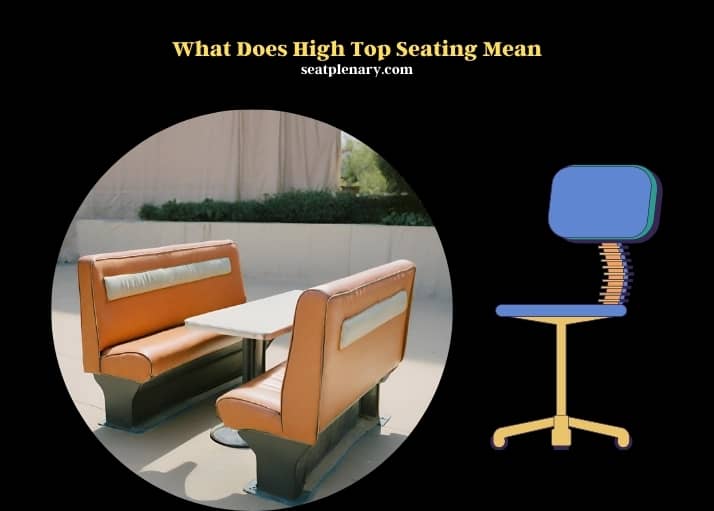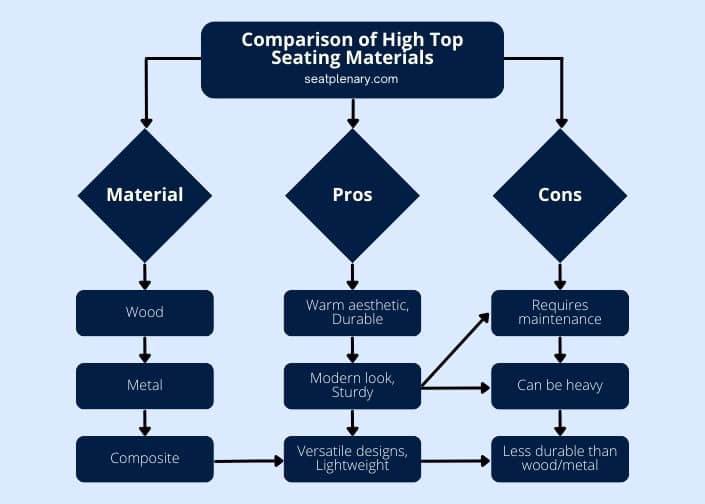High top seating refers to tall chairs and tables, typically found in bars and restaurants. These pieces of furniture are higher than standard dining tables and chairs, often paired with bar stools.
High top seating has become a popular choice in various settings beyond its traditional use in bars and pubs. Its unique height makes it a versatile option for creating a dynamic and engaging atmosphere in different environments. In modern interior design, high top tables and chairs are often used to add a sense of openness and casual elegance to a space. They are particularly effective in areas where the goal is to encourage social interaction and a relaxed ambiance, such as in coffee shops, casual dining establishments, and even in residential kitchen and dining areas.

The design of high top seating varies widely, incorporating different materials like wood, metal, and composites to suit various aesthetic and functional needs. Ergonomics also play a crucial role in the design of high top seating, ensuring comfort despite the increased height. The choice of high top seating can significantly influence the overall look and feel of a space, making it a key consideration in both commercial and residential interior design. Its rising popularity reflects a broader trend towards more versatile and socially-oriented living and dining spaces.
High Top Seating: Tracing its Roots and Significance
High top seating, a term often heard in interior design and furniture, refers to chairs and tables that are taller than standard furniture. Its origins can be traced back to the bustling pubs of Europe, where space was at a premium, and the need for more standing room led to the creation of taller tables and chairs. This design allowed patrons to either stand or sit on elevated stools, making conversations easier in crowded spaces. Over time, high top seating evolved from a purely functional piece to a significant element in design aesthetics.
The historical evolution of high top seating reflects a journey from practicality to a symbol of modernity and style. Its design principles have been influenced by various cultural and social factors. For instance, in the 20th century, the rise of the American diner brought a new wave of high top seating designs, incorporating chrome finishes and leather upholstery, reflecting the era’s cultural ethos.
High top seating’s cultural significance is also noteworthy. It has become synonymous with a casual, social atmosphere, often found in cafes, bars, and restaurants. Its presence in a space suggests a laid-back yet lively ambiance, inviting patrons to engage in leisurely dining and conversations.
Diverse Designs and Materials in High Top Seating
The world of high top seating is rich in variety, offering a plethora of designs that cater to different aesthetic preferences and functional needs. The choice of materials in high top seating varies widely, ranging from traditional wood to modern metals and composites. Each material brings its unique texture, weight, and durability, influencing the overall design and usage of the furniture.
Wooden high top tables and chairs, for instance, offer a classic and warm appeal, often found in traditional pubs and rustic-themed restaurants. On the other hand, metal high top seating, with its sleek and contemporary look, is a common sight in modern cafes and bistros.
Ergonomic considerations are also crucial in the design of high top seating. The height of the chairs and tables must be balanced to ensure comfort, especially for prolonged sitting. The inclusion of footrests on high chairs and the stability of the tables are key ergonomic aspects that designers focus on.
Aesthetic diversity in high top seating is evident in the various styles available. From minimalist designs that feature clean lines and neutral colors to ornate pieces with intricate details and bold hues, high top seating can significantly influence the ambiance of a space.
Comparison of High Top Seating Materials
| Material | Pros | Cons |
| Wood | Warm aesthetic, Durable | Requires maintenance |
| Metal | Modern look, Sturdy | Can be heavy |
| Composite | Versatile designs, Lightweight | Less durable than wood/metal |

High Top Seating in Contemporary Interior Design
In modern interior design, high top seating has found a prominent place, blending functionality with style. Its integration into contemporary spaces reflects a shift towards more dynamic and versatile furniture arrangements. High top seating is no longer confined to bars and restaurants; it’s increasingly seen in homes, offices, and various commercial spaces.
The influence of high top seating on ambiance is significant. It can create a focal point in a room, adding height and dimension to the space. In open-plan areas, high top tables serve as informal meeting spots or dining areas, facilitating interaction while maintaining a sense of openness.
Current design trends in high top seating show a preference for minimalist and industrial styles. These trends emphasize clean lines, neutral color palettes, and the use of materials like steel and glass. The popularity of these trends reflects a broader shift in interior design towards simplicity and functionality.
Pros and Cons of High Top Seating
High top seating offers several benefits, making it a popular choice in various settings. One of its primary advantages is space optimization. High top tables and chairs take up less floor space, making them ideal for small apartments, cafes, and bars. They also promote a more casual and social atmosphere, encouraging interaction among users.
Comfort and accessibility are key considerations in high top seating. While the elevated position offers a unique perspective and can be comfortable for short durations, it may not be suitable for everyone, especially those with mobility issues. Ensuring that high top seating is paired with appropriate ergonomics is essential for comfort.
Maintenance is another aspect to consider. Depending on the materials used, high top seating can require regular upkeep to maintain its appearance and functionality. For instance, wooden high top tables may need periodic treatment to protect against wear and tear.
High Top Seating Ergonomics
| Feature | Importance |
| Height | Ensures comfort and accessibility |
| Footrest | Reduces leg strain |
| Stability | Prevents tipping and enhances safety |

Future Directions in High Top Seating Design
The future of high top seating looks promising, with several trends and innovations shaping its evolution. Technological advancements are playing a significant role, with designers experimenting with smart furniture concepts. For example, high top tables with integrated charging ports and touch screens are becoming more common, reflecting the needs of a tech-savvy generation.
Sustainability is another key trend in high top seating design. There is an increasing demand for eco-friendly materials and production methods. Designers are exploring the use of recycled materials and sustainable wood sources to create high top seating that is not only stylish but also environmentally responsible.
Consumer preferences are also influencing the future of high top seating. As people seek more personalized and unique furniture, custom high top seating options are becoming popular. These allow individuals to choose materials, colors, and designs that reflect their personal style and fit their specific space requirements.
Frequently Asked Questions (FAQs)
Is High Top Seating Suitable for All Spaces?
High top seating, known for its elevated design, isn’t universally suitable for all spaces. Its appropriateness largely depends on the specific needs and layout of an area. In environments where space is limited, such as small cafes or apartment kitchens, high top seating can be a smart choice. It takes up less floor space and can create a sense of openness.
In settings where comfort for extended periods is a priority, like in a traditional dining room, standard-height seating might be more appropriate. The key is to consider the intended use and the users’ comfort.
Can High Top Seating Be Comfortable for Long Periods?
While high top seating offers a unique aesthetic and can be ideal for brief sitting periods, its comfort over longer durations is debatable. The elevated nature of these seats can lead to discomfort, especially if footrests are not properly positioned or if the seating lacks adequate back support. For settings like bars or casual dining spots where patrons typically stay for shorter periods, high top seating is an excellent choice.
For environments like workplaces or homes where people might sit for longer, more ergonomic options should be considered.
How Does High Top Seating Affect Room Dynamics?
High top seating can significantly influence the dynamics of a room. Its elevated stature adds a vertical dimension to spaces, often making them appear more open and less cluttered. This type of seating encourages a casual, social atmosphere, ideal for interactive environments like bars or open-plan kitchens.
It’s important to balance high top seating with other elements in the room to avoid a sense of disproportion. Proper lighting and complementary furniture can help integrate high top seating seamlessly into the overall design.
Are There Adjustable High Top Seating Options?
Adjustable high top seating is an innovative solution that caters to the need for versatility in furniture design. These adjustable options allow for the height of the seating to be modified, making them suitable for various purposes and user heights. This adaptability makes them a practical choice for multi-use spaces or in homes where flexibility is desired. Adjustable high top seating combines the benefits of standard and high top seating, offering a practical solution for diverse needs.
What Maintenance Does High Top Seating Require?
The maintenance required for high top seating depends on the materials used in its construction. For instance, high top seating made of wood may need regular treatment to protect against wear and moisture. Metal or plastic options might require less maintenance but should be regularly checked for stability and wear. Cleaning practices also vary; some materials might need special cleaning agents to avoid damage. Regular maintenance ensures the longevity and appearance of high top seating, making it a lasting addition to any space.
How Does High Top Seating Impact Accessibility?
High top seating can pose accessibility challenges for certain individuals, including those with mobility issues or children. The elevated height can make it difficult for some to comfortably sit or leave the seating. Inclusive design principles suggest incorporating a variety of seating options to accommodate all users. Venues like restaurants or public spaces should consider mixing high top seating with standard-height tables and chairs to ensure accessibility for everyone. This approach ensures that the space is welcoming and comfortable for a diverse range of users.
Conclusion
High top seating, with its rich history and evolving design, continues to be a significant element in interior design. From its practical origins to its modern applications, it offers a unique blend of functionality and style. As we look to the future, high top seating is set to become even more innovative and sustainable, reflecting the changing needs and preferences of consumers. Whether in a bustling cafe or a cozy home kitchen, high top seating remains a versatile and stylish choice for any space.
